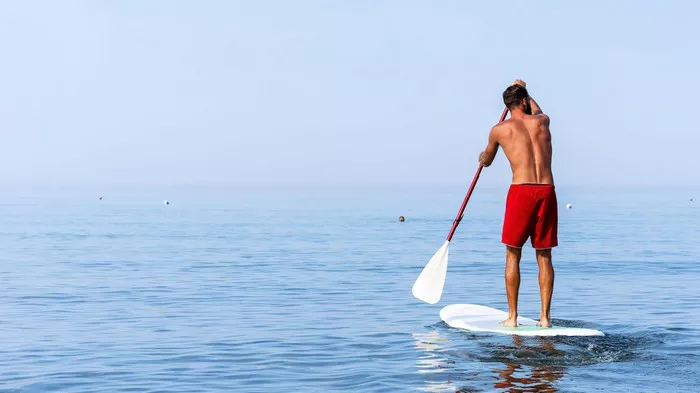Paddle boarding is a serene and enjoyable water sport that has gained widespread popularity for its accessibility and health benefits. Whether you’re a beginner or looking to refine your technique, learning how to confidently get on a paddle board is essential. This article will guide you through the step-by-step process of mounting a paddle board safely and efficiently, helping you embark on your paddling adventures with confidence.
Understanding the Basics
Before we delve into the technique of getting on a paddle board, it’s important to familiarize yourself with the key components and types of paddle boards available. Paddle boards vary in size, shape, and construction, with options ranging from solid to inflatable boards. For beginners, wider and more stable boards are recommended as they offer better balance and maneuverability, making them easier to mount.
Understanding Your Equipment
Before stepping onto a paddle board, it’s important to become familiar with the equipment you’ll be using:
1. Paddle Board: Typically, paddle boards are large, stable platforms designed to support standing. They come in various sizes and shapes, with wider boards providing more stability, making them ideal for beginners.
2. Paddle: Paddles are used to propel the board through the water. When choosing a paddle, ensure it’s the right length for your height—standing next to the paddle, the handle should reach your wrist when your arm is raised overhead.
3. Personal Flotation Device (PFD): It’s crucial to wear a PFD, especially in deep or fast-moving water. Choose a comfortable and properly fitting PFD that won’t restrict your movement.
Preparing for Board Entry
To begin, find a suitable location to launch your paddle board. Look for calm, shallow waters with minimal waves and obstacles. Lay the paddle board parallel to the shoreline, ensuring that the fin (located at the rear underside of the board) is facing the water. Place the paddle across the board within easy reach.
Step-by-Step Guide to Getting on a Paddle Board
1. Enter the Water Gracefully: Stand next to the paddle board in shallow water, holding the paddle with one hand and using the other to stabilize yourself by placing it on the board. Keep the paddle perpendicular to the board for balance.
2. Position Yourself Correctly: Position yourself so that you’re facing the side of the board. If the board is on your right, your body should face to the left and vice versa.
3. Kneel on the Board: Begin by kneeling on the paddle board, placing both knees near the centerline for stability. Keep your knees about shoulder-width apart.
4. Maintain Balance: As you stabilize yourself on your knees, keep your core engaged and your back straight. This will help you maintain balance as you transition to standing.
5. Transition to a Standing Position: Gradually shift your weight forward while placing one foot at a time on the board. Start with the foot closest to the centerline and then step onto the board with the other foot.
6. Find Your Balance: Once both feet are firmly on the board, adjust your stance to find a comfortable and balanced position. Your feet should be hip-width apart, with your toes pointing forward.
7. Stand Up Slowly: Use your paddle to assist with balance as you stand upright. Keep your knees slightly bent to absorb any movement of the board.
Tips for Success
1. Start in Calm Waters: Begin in calm, flat waters without strong winds or currents.
2. Practice Paddle Skills: Before standing, practice paddling while kneeling to get a feel for the board’s stability.
3. Focus on Core Strength: A strong core is essential for balance; incorporate core-strengthening exercises into your routine.
4. Use Your Paddle Wisely: Your paddle is not just for propulsion; it’s also a balancing tool. Use it to brace yourself when needed.
5. Practice Makes Perfect: Don’t be discouraged if you struggle initially. Practice getting on and off the paddle board in calm conditions until you feel confident.
6. Use Proper Technique: Focus on using your core muscles for stability rather than relying solely on your arms and legs.
7. Stay Relaxed: Tension can affect your balance, so try to stay relaxed and maintain a fluid posture.
8. Choose the Right Board: Ensure that your paddle board suits your skill level and weight for optimal stability.
Common Mistakes to Avoid
- Leaning Back: Keep your weight centered and avoid leaning too far back, as this can cause the nose of the board to lift out of the water.
- Standing Too Quickly: Take your time to find your balance; rushing to stand can lead to a loss of stability.
- Neglecting Safety Gear: Always wear a PFD and consider a helmet in certain conditions, especially if paddling in rough waters.
Conclusion
Mastering the art of getting on a paddle board is a fundamental skill that every paddle boarder should learn. By following these step-by-step instructions and practicing regularly, you’ll build the confidence and ability needed to enjoy this exhilarating water sport to the fullest. Remember to prioritize safety and always wear a personal flotation device when paddle boarding, especially in unfamiliar waters. So, grab your paddle and board, head to the nearest water body, and embark on your paddle boarding journey with skill and poise!


